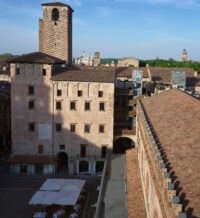Like the French remake of Les Misérables, a homeowner in the Parisian suburb of Corbett-Essonne discovers that his house is built on an ancient cemetery. The owner was renovating his cellar late last year when he came across a skeleton. A comprehensive excavation of four rooms of the crypt by the Regional Archaeological Service revealed 38 tombs dating from the 3rd to 10th centuries AD
The tombs are spread out over four chambers in the crypt, mostly in parallel rows. The dead in late empire tombs were buried on their backs in wooden coffins and then buried in deep pits. The wood has rotted away, but there are still traces of the original shape of the coffin in the pit.
 The ranks were retained, with only a slight shift eastward between Late Antiquity and the Merovingian period. There are 10 unique gypsum sarcophagi from the Merovingian period (AD 476-750), arranged side by side in a fan shape. Although some plaster sarcophagi found elsewhere have decorations on their outer walls, none of the 10 sarcophagi in the cellar have decorations on their walls. One of the sarcophagi had a lid – a soft stone – with carvings on it. The cover is broken, but part of the rose window, a Latin cross and a cross within a circle can be discerned.
The ranks were retained, with only a slight shift eastward between Late Antiquity and the Merovingian period. There are 10 unique gypsum sarcophagi from the Merovingian period (AD 476-750), arranged side by side in a fan shape. Although some plaster sarcophagi found elsewhere have decorations on their outer walls, none of the 10 sarcophagi in the cellar have decorations on their walls. One of the sarcophagi had a lid – a soft stone – with carvings on it. The cover is broken, but part of the rose window, a Latin cross and a cross within a circle can be discerned.
 A medieval cemetery has existed in the area since the first gypsum sarcophagus was discovered in the 19th century, but the remains have not been formally excavated or scientifically studied. This is the first comprehensive examination of the cemetery, and the dating of the oldest graves proves that the cemetery was used much earlier than previously recognized.
A medieval cemetery has existed in the area since the first gypsum sarcophagus was discovered in the 19th century, but the remains have not been formally excavated or scientifically studied. This is the first comprehensive examination of the cemetery, and the dating of the oldest graves proves that the cemetery was used much earlier than previously recognized.
The remains have all been removed and transferred to a laboratory for further study.


 Anal Beads
Anal Beads Anal Vibrators
Anal Vibrators Butt Plugs
Butt Plugs Prostate Massagers
Prostate Massagers
 Alien Dildos
Alien Dildos Realistic Dildos
Realistic Dildos
 Kegel Exercisers & Balls
Kegel Exercisers & Balls Classic Vibrating Eggs
Classic Vibrating Eggs Remote Vibrating Eggs
Remote Vibrating Eggs Vibrating Bullets
Vibrating Bullets
 Bullet Vibrators
Bullet Vibrators Classic Vibrators
Classic Vibrators Clitoral Vibrators
Clitoral Vibrators G-Spot Vibrators
G-Spot Vibrators Massage Wand Vibrators
Massage Wand Vibrators Rabbit Vibrators
Rabbit Vibrators Remote Vibrators
Remote Vibrators
 Pocket Stroker & Pussy Masturbators
Pocket Stroker & Pussy Masturbators Vibrating Masturbators
Vibrating Masturbators
 Cock Rings
Cock Rings Penis Pumps
Penis Pumps
 Wearable Vibrators
Wearable Vibrators Blindfolds, Masks & Gags
Blindfolds, Masks & Gags Bondage Kits
Bondage Kits Bondage Wear & Fetish Clothing
Bondage Wear & Fetish Clothing Restraints & Handcuffs
Restraints & Handcuffs Sex Swings
Sex Swings Ticklers, Paddles & Whips
Ticklers, Paddles & Whips




















